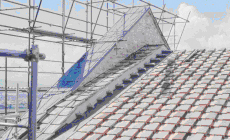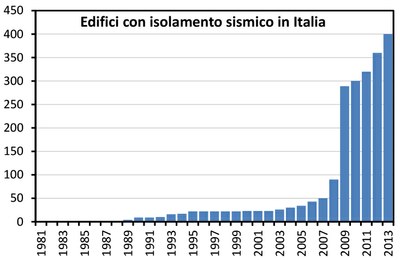Earthquakes: Italy leading country for applications of anti-seismic systems but critical situations still affect safety of building stock
4/2/2016

Italy is one of the leading countries in the world for number of seismic isolated structures – it ranks fifth after much more densely populated countries such as Japan, China, Russia, the United States – and it’s first in Europe for the application of isolation and energy dissipation systems to buildings, bridges and viaducts.
Italy leads the world in terms of anti-seismic devices for the protection of cultural heritage.
However, as regards seismic safety of the domestic building stock, there still are many critical situations: in fact, “over 70% of the buildings wouldn’t withstand the earthquakes that can hit them, including schools, hospitals and many other strategic structures”.
ENEA gave its contribution to the restoration of the Basilica Superiore di San Francesco d’Assisi, following damage from the 1997-98 earthquake in Umbria and Abruzzi, playing a key role in the development of shape-memory alloy devices.
The Special Issue “100 years of Seismic Engineering”, published on the 100th anniversary of the earthquake in Avezzano that on 13 January 1915 caused 30 thousand casualties and destroyed around 20 towns, enhances the Nation’s technological excellence but also its building fragility and the necessity for an effective prevention policy.
Is there a risk that catastrophes like this could happen again? And what’s being done to prevent earthquakes from taking place and to reduce their impacts?
The ENEA special issue makes a distinction between new and existing structures: for the first there are technical solutions to be applied in order to construct buildings, bridges and infrastructures capable to withstand even major earthquakes. “Modern anti-seismic technologies can guarantee a degree of safety that traditional techniques can’t provide, with no additional cost“, the experts say.
As for existing structures, when possible “a greater use of modern technologies, especially as concerns seismic isolation, would be advisable” particularly for countries like Italy where, the experts say, “most of the buildings can’t stand up to the level of seismic activity established by the current regulation for new buildings in their respective sites”.
Most of our buildings are over 50 years old and were built hurriedly and without appropriate controls; this facilitated the use of poor quality materials and poor construction methods-Paolo Clemente, the ENEA expert author of the special issue points out- In addition, incorrect architectural and/or structural interventions have often accelerated the effects of aging and degradation, worsened by poor, or lack of, maintenance.
On the other hand, in Italy there are over 400 seismic isolated buildings and artistic heritage assets-such as the Bronzi di Riace, which stand on an anti-seismic basement developed by ENEA which, together with the Politecnico di Torino, has also patented an anti-seismic system for complex structures.
Hence the need, the experts warn, of an effective prevention policy based on a sound budgeting and action plan and the definition of priorities regarding hazard and the structural conditions of buildings, particularly for strategic structures such as schools, hospitals, prefectures, barracks.
But how can we make buildings and infrastructures resistant to earthquakes? As of today, there are mainly three ways: the conventional method consists in making the structure strong enough to be able to withstand the strongest earthquake which is likely to occur at its site, another envisages the application of seismic isolation devices dramatically reducing the seismic forces transmitted from the ground to the structure, the third incorporates both methods.
Seismic isolation systems allow for much higher safety levels : a new seismic isolated building (if designed properly) can survive a potentially devastating seismic impact, also preserving its contents.
It’s generally possible to install seismic isolation systems in new buildings and, in medium and high seismic areas, if well designed, with no additional construction costs.
The application of anti-seismic systems to existing buildings is not always possible, due to technical reasons (possibility of carrying out safe interventions at the base of the building, proximity of other buildings, etc.) and economic reasons.
Globally, in 2013 the number of seismic isolated structures was over 23.000 in more than 30 countries: bridges and viaducts, civil and industrial buildings, facilities, including nuclear and chemical plants at risk of major accidents. The materials employed range from reinforced concrete to steel and even wood.
Japan still ranks first for total number of AS systems, which are steadily increasing (in mid - 2011 the isolated buildings were around 6.600 and those with dissipative systems around 3.000). However, already in 2013, China was moving up the chart, followed by Russia, the US and Italy.Italy has a leading position in Europe in the use of isolation and energy dissipation systems in buildings, bridges and viaducts and has strengthened its role after the Abruzzi earthquake in 2009: in the city of l’Aquila alone, the new buildings isolated with life-saving systems are more than one hundred, both new constructions and retrofitted existing buildings.
Italy also holds a leading position globally in the use of AS systems for the protection of cultural heritage, having developed major projects in this sector; moreover, systems manufactured in Italy are also used in other countries, like Cyprus, Russia, Indonesia, Iran, Greece, Portugal, Spain, Turkey and so on.
The experts point out, however, that in order to ensure real life-saving protection and avoid the risk of making the structure less safe than it was originally, seismic systems must be correctly designed and installed and this is particularly true “for isolators, they must be accurately selected, designed, manufactured, verified, installed, protected and inspected, making sure their design features remain unchanged during the entire useful life of the structure”
For more information please contact:
Paolo Clemente, ENEA Casaccia Research Center, paolo.clemente@enea.it


 No. 5 september-october
No. 5 september-october